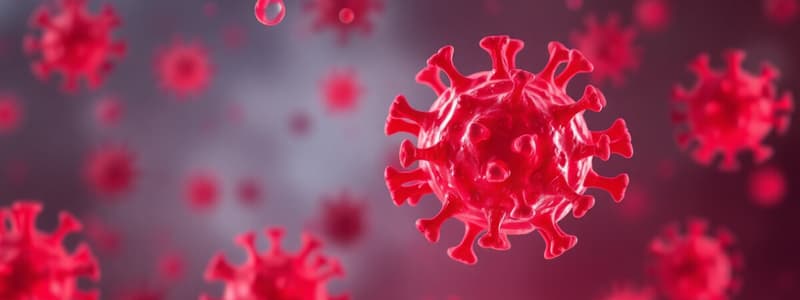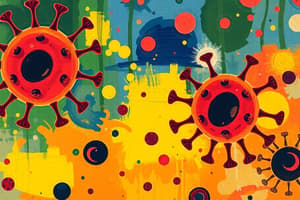Podcast
Questions and Answers
Which of the following is the MOST potent mediator involved in Type I hypersensitivity reactions, leading to symptoms such as bronchial constriction and edema?
Which of the following is the MOST potent mediator involved in Type I hypersensitivity reactions, leading to symptoms such as bronchial constriction and edema?
- Histamine (correct)
- Cytokines
- Complement
- IgG
In a Type II hypersensitivity reaction, how does the antibody (IgG or IgM) typically cause cell destruction?
In a Type II hypersensitivity reaction, how does the antibody (IgG or IgM) typically cause cell destruction?
- By forming immune complexes that deposit in tissue.
- By activating complement and initiating phagocytosis. (correct)
- Through the release of histamine from mast cells.
- By directly inducing apoptosis in the target cell.
What is the PRIMARY mechanism by which tissue damage occurs in Type III immune complex-mediated hypersensitivity reactions?
What is the PRIMARY mechanism by which tissue damage occurs in Type III immune complex-mediated hypersensitivity reactions?
- Histamine release from mast cells causing vasodilation and edema.
- IgE-mediated sensitization of mast cells.
- Direct cytotoxicity by T lymphocytes.
- Complement activation and neutrophil degranulation. (correct)
Which type of cells are DIRECTLY responsible for the tissue damage observed in Type IV hypersensitivity reactions?
Which type of cells are DIRECTLY responsible for the tissue damage observed in Type IV hypersensitivity reactions?
How does the antibody mediate its effect in the fifth mechanism of hypersensitivity, using Myasthenia Gravis as an example?
How does the antibody mediate its effect in the fifth mechanism of hypersensitivity, using Myasthenia Gravis as an example?
Systemic lupus erythematosus (SLE) is an example of an autoimmune disease. What is the MOST characteristic autoantibody found in individuals with SLE?
Systemic lupus erythematosus (SLE) is an example of an autoimmune disease. What is the MOST characteristic autoantibody found in individuals with SLE?
Why are Type O individuals considered universal donors for blood transfusions?
Why are Type O individuals considered universal donors for blood transfusions?
In the context of alloimmunity, which scenario BEST exemplifies this type of immune reaction?
In the context of alloimmunity, which scenario BEST exemplifies this type of immune reaction?
What is the underlying cause of a primary (congenital) immune deficiency?
What is the underlying cause of a primary (congenital) immune deficiency?
Which of the following is the MOST common cause of secondary (acquired) immune deficiencies?
Which of the following is the MOST common cause of secondary (acquired) immune deficiencies?
Which of the following best describes the role of H2 receptors in Type I hypersensitivity reactions?
Which of the following best describes the role of H2 receptors in Type I hypersensitivity reactions?
Raynaud’s phenomenon is an example of which type of hypersensitivity reaction and what causes the local pallor and numbness?
Raynaud’s phenomenon is an example of which type of hypersensitivity reaction and what causes the local pallor and numbness?
Which of the following examples BEST represents a Type IV hypersensitivity reaction?
Which of the following examples BEST represents a Type IV hypersensitivity reaction?
In the context of autoimmune diseases, what is the PRIMARY difference between central tolerance and peripheral tolerance?
In the context of autoimmune diseases, what is the PRIMARY difference between central tolerance and peripheral tolerance?
Given that Type AB individuals lack both anti-A and anti-B antibodies, what is the implication for blood transfusions?
Given that Type AB individuals lack both anti-A and anti-B antibodies, what is the implication for blood transfusions?
Which of the following replacement therapies is designed to directly enhance or modulate the immune system's response?
Which of the following replacement therapies is designed to directly enhance or modulate the immune system's response?
An individual with Type A blood receives a transfusion of Type B blood. What immunological reaction is MOST likely to occur?
An individual with Type A blood receives a transfusion of Type B blood. What immunological reaction is MOST likely to occur?
Which of the following is NOT typically considered a cause of secondary immune deficiency?
Which of the following is NOT typically considered a cause of secondary immune deficiency?
In Type III hypersensitivity reactions, why are neutrophils attracted to the sites of immune complex deposition and what is the consequence of their activity?
In Type III hypersensitivity reactions, why are neutrophils attracted to the sites of immune complex deposition and what is the consequence of their activity?
Why are nonsteroidal anti-inflammatory drugs (NSAIDs) and antimalarial drugs used in the treatment of Systemic Lupus Erythematosus (SLE)?
Why are nonsteroidal anti-inflammatory drugs (NSAIDs) and antimalarial drugs used in the treatment of Systemic Lupus Erythematosus (SLE)?
Flashcards
Hypersensitivity
Hypersensitivity
Altered immunologic response to an antigen, causing damage or disease to the host.
Type I Hypersensitivity
Type I Hypersensitivity
Mediated by IgE, involves mast cells and histamine release, leading to vasodilation, edema, and bronchial constriction.
Type II Hypersensitivity
Type II Hypersensitivity
Tissue-specific, where antibodies (IgG or IgM) target a specific cell or tissue, leading to its destruction.
Type III Hypersensitivity
Type III Hypersensitivity
Signup and view all the flashcards
Type IV Hypersensitivity
Type IV Hypersensitivity
Signup and view all the flashcards
Fifth Hypersensitivity Mechanism
Fifth Hypersensitivity Mechanism
Signup and view all the flashcards
Allergy
Allergy
Signup and view all the flashcards
Autoimmunity
Autoimmunity
Signup and view all the flashcards
Alloimmunity
Alloimmunity
Signup and view all the flashcards
Transfusion Reaction
Transfusion Reaction
Signup and view all the flashcards
Immune Deficiency
Immune Deficiency
Signup and view all the flashcards
Primary Immune Deficiency
Primary Immune Deficiency
Signup and view all the flashcards
Secondary Immune Deficiency
Secondary Immune Deficiency
Signup and view all the flashcards
Type A Blood
Type A Blood
Signup and view all the flashcards
Type O Blood
Type O Blood
Signup and view all the flashcards
Type AB Blood
Type AB Blood
Signup and view all the flashcards
Study Notes
- Hypersensitivity is an altered immune response to an antigen, leading to host damage or disease.
- Sensitization to antigens can vary in speed among individuals.
- Hypersensitivity reactions can be immediate (minutes to hours) or delayed (hours to days).
- Hypersensitivity is classified by antigen source (allergy, autoimmunity, alloimmunity) and disease mechanism (Types I-IV).
- Hypersensitivity mechanisms are interrelated and can occur simultaneously.
Type I: IgE-Mediated Reactions
- Type I reactions involve tissue mast cells and are commonly associated with environmental allergies.
- Histamine is the most potent mediator, causing bronchial constriction, increased vascular permeability, edema, and vasodilation.
- H2 receptors can decrease histamine release and increase gastric secretion.
- Antihistamines can mitigate Type I responses by blocking histamine receptors.
Type II: Tissue-Specific Reactions
- Type II reactions target specific cells or tissues.
- Symptoms vary depending on the affected tissue or organ.
- IgG or IgM antibodies can trigger the complement cascade, leading to cell destruction via the classical pathway.
- Macrophages may phagocytize target cells, causing destruction.
Type III: Immune Complex-Mediated Reactions
- Type III reactions involve antigen-antibody complexes deposited in vessel walls or tissues.
- Complement activation, particularly the generation of chemotactic factors for neutrophils, is a harmful effect.
- Neutrophils release granules and toxic oxygen products, damaging healthy tissue while trying to phagocytize, especially when combined with toxic oxygen products from target cells.
- Raynaud’s phenomenon, caused by temperature-dependent immune complex deposition, is an example of a Type III reaction.
- Immune complex precipitates block circulation, causing pallor, numbness, cyanosis, and potentially gangrene.
Type IV: Cell-Mediated Reactions
- Type IV reactions are cell-mediated by cytotoxic T lymphocytes and do not involve antibodies.
- Tissue destruction results from Tc cell toxins or factors like lysosomal enzymes and reactive oxygen species from macrophages.
- Graft rejection and allergic contact reactions (e.g., poison ivy) are examples of Type IV hypersensitivity.
Fifth Mechanism
- The fifth mechanism involves antibodies modulating target cell function without destroying the cell.
- Antibodies can prevent ligand interactions, replace ligands, or eliminate receptors.
- Myasthenia Gravis, where antibodies bind to Ach receptors at the neuromuscular junction, exemplifies this mechanism.
Allergy
- Allergy refers to the harmful effects of hypersensitivity to environmental antigens.
Autoimmunity
- Autoimmunity is a disturbance in self-antigen immunologic tolerance.
- Autoimmune diseases often result from a breakdown in peripheral tolerance.
- Systemic lupus erythematosus, where autoantibodies target nucleic acids and other self-components, is an example.
- Lupus can cause congenital heart defects or pregnancy loss.
- Mild lupus is treated with NSAIDs; serious cases use antimalarials, immunosuppressants, or IVIg.
Alloimmunity
- Alloimmunity occurs when one individual's immune system reacts against another's tissues or organs.
- Examples include transplants, skin grafts, blood transfusions, and reactions to a fetus during pregnancy.
Transfusion Reactions
- Type A blood has Type B antibodies; transfusion with Type B or AB blood causes a severe reaction and erythrocyte destruction.
- Type O individuals lack A and B antigens, making them universal donors.
- Type AB individuals lack anti-A and anti-B antibodies, making them universal recipients.
Immune Deficiency
- Immune deficiency is a failure of self-defense mechanisms, increasing infection susceptibility.
- Primary (congenital) immune deficiency is caused by genetic anomalies.
- Secondary (acquired) immune deficiency results from illness or aging and is more common.
- Pregnancy, though immunocompromised, does not significantly alter infection rates.
- Other secondary deficiencies can be caused by psychological stress, dietary issues, chronic diseases, malignancies, physical trauma etc.
Replacement Therapies for Immune Deficiencies
- Gamma-globulin
- Transplantation and Transfusion
- Immune Modulators via Gene Therapy
Studying That Suits You
Use AI to generate personalized quizzes and flashcards to suit your learning preferences.




